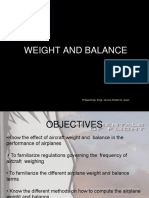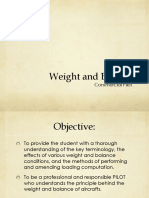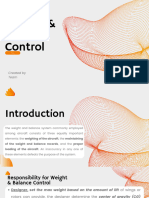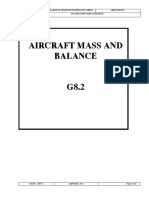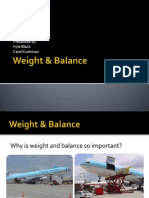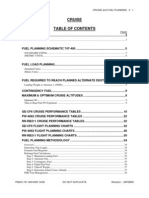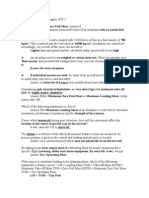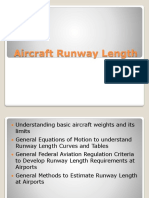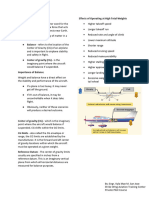FPP Weight and Balance Reviewer
FPP Weight and Balance Reviewer
Uploaded by
RyanCopyright:
Available Formats
FPP Weight and Balance Reviewer
FPP Weight and Balance Reviewer
Uploaded by
RyanCopyright
Available Formats
Share this document
Did you find this document useful?
Is this content inappropriate?
Copyright:
Available Formats
FPP Weight and Balance Reviewer
FPP Weight and Balance Reviewer
Uploaded by
RyanCopyright:
Available Formats
FLIGHT PERFORMANCE AND PLANNING
(Basic Weight and Balance)
An airplane must only be flown within certified limits of weight and balance to
ensure that it remains controllable, performs adequately and is not
overstressed.
(1) Effects of increased weight:
→ Higher takeoff speed required → Higher stalling speed
→ Longer takeoff run required → Higher landing speed required
→ Reduced rate and angle of climb → Longer landing roll required
→ Shorter range → Lower maximum altitude
→ Reduced cruising speed → Excessive weight on the nosewheel
→ Reduced maneuverability
(2) Effects of balance on stability and flight performance:
→ An airplane loaded near the forward CG limit becomes more stable, but
less controllable in flight, while an airplane loaded near the aft limit is less stable,
but more sensitive to control input.
Effects of beyond forward C.G. loading:
1. Higher takeoff speed
2. Greater distance of ground roll
3. Reduced rate of climb
4. Decreased maximum altitude
5. Reduced maneuverability
6. Higher stalling speed
7. Reduction in performance caused by increased tail down force
8. Reduced pitch authority
Effects of beyond aft C.G. loading:
1. Decreased stability
2. Higher susceptibility to over-control
3. Higher risk of stalls and spins of which recovery may be difficult or
impossible
*If the airplane CG falls beyond the forward or aft limits, the airplane is potentially
unstable and should be considered unsafe to fly.
(3) Terms:
FOR TRAINING PURPOSES ONLY
Arm (Moment Arm) – the horizontal distance in inches from the reference
datum line to the center of gravity of any item. Positive (+) if measured aft,
negative (-) if forward of the datum.
Basic Empty Weight – the combined weight of airframe, engines and all
operating equipment that has a fixed location and permanently installed in the
airplane (includes optional and special equipment, fixed ballast, hydraulic fluid,
unusable fuel and oil).
Center of Gravity (CG) – the point about which an airplane would balance
if suspended at that point.
Center of Gravity Limits – the specified forward and aft points within
which the CG must be located during flight for safe control and maneuverability.
Center of Gravity Range – the distance between the forward and aft limits.
Datum (Reference Datum) – an imaginary vertical plane or line from
which all measurements of arm are taken (established by the manufacturer).
Fuel Load – the usable part of the fuel load of the airplane.
Gross Weight – the loaded weight of the airplane (includes the basic empty
weight of the airplane, all usable fuel, and all persons and baggage).
Maximum Landing Weight – the maximum weight at which an airplane ay
normally be landed.
Maximum Ramp Weight – the maximum weight approved for ground
maneuvers (includes weight of start, taxi, and run-up fuel).
Maximum Takeoff Weight – the maximum allowable weight at the start of
the takeoff run.
Maximum Zero Fuel Weight – the maximum weight with no fuel on board.
Moment – the product of the weight of an item multiplied by its arm
(expressed in lb.-in. or in.-lb.)
Moment Index (or Index) – a moment divided by a constant such as 100,
1000, or 10,000.
Standard Weights – established for numerous items in weight and balance
computations (gasoline = 6 lb./US gal.; oil = 7.5 lb./US gal.; water = 8.35 lb./US
gal.; genav - crew and pax = 170 lb. each).
FOR TRAINING PURPOSES ONLY
Station – location along the airplane fuselage given in terms of distance
from the reference datum.
Useful Load – the difference between takeoff weight and the basic empty
weight.
(4) Three methods for computing Weight & Balance:
1. Computational method
2. Graph method
3. Table method
Weight × Arm = Moment
C.G. = Total Moment ÷ Total Weight
Summary notes:
Both the amount and distribution of weight significantly affect aircraft
stability, control, and efficiency.
An airplane may have a single maximum weight limit or multiple weight
limits for various stages of ground and flight operations.
Maximum weight limits may be required for structural or performance
considerations.
The three methods for computing weight and balance are: Computational,
Graph, and Table.
FOR TRAINING PURPOSES ONLY
You might also like
- PPL Flight Performance and Planning PDFDocument94 pagesPPL Flight Performance and Planning PDFNicolo iris Esteban100% (1)
- 787 DescriptionDocument161 pages787 DescriptionJavier Castaños Ruiz100% (4)
- Aircraft General Knowledge (WEIGHT & BALANCE)Document37 pagesAircraft General Knowledge (WEIGHT & BALANCE)Azuma Cenation Azra100% (1)
- Weight and Balance NewDocument41 pagesWeight and Balance NewAira HernandezNo ratings yet
- (Your N-Number Here) : Rans S-6EsDocument52 pages(Your N-Number Here) : Rans S-6Esviorelu99No ratings yet
- Performance LandingDocument17 pagesPerformance LandingBFBGFD100% (3)
- Steady Aircraft Flight and PerformanceFrom EverandSteady Aircraft Flight and PerformanceRating: 5 out of 5 stars5/5 (2)
- Airman Certification Standards: Flight Instructor - Airplane (2025): FAA-S-ACS-25From EverandAirman Certification Standards: Flight Instructor - Airplane (2025): FAA-S-ACS-25No ratings yet
- Oral and Practical Review: Reflections on the Part 147 CourseFrom EverandOral and Practical Review: Reflections on the Part 147 CourseNo ratings yet
- CPL Weight and BalanceDocument52 pagesCPL Weight and BalanceKakashi Hatake100% (1)
- PPL Weight and BalanceDocument17 pagesPPL Weight and BalanceDyava SavitraNo ratings yet
- Amt 113 - Weight and Balance LecDocument67 pagesAmt 113 - Weight and Balance LecNino AngobNo ratings yet
- AMT2206 Prelim Lec Module 1 & 2Document18 pagesAMT2206 Prelim Lec Module 1 & 2Nino AngobNo ratings yet
- Weight & Balance UnjDocument61 pagesWeight & Balance UnjRoni Al Habsy100% (1)
- RYAN DOMANDE New (61 PG)Document61 pagesRYAN DOMANDE New (61 PG)Filippo CiaravoloNo ratings yet
- Weight and Balance LPDocument17 pagesWeight and Balance LPKyle HawkinsNo ratings yet
- General Weight and BalanceDocument30 pagesGeneral Weight and Balancehansen majayaNo ratings yet
- Lecture 2-Composition of Aircraft WeightDocument25 pagesLecture 2-Composition of Aircraft WeightLevent Önder0% (2)
- Weight Balance PPT 1Document40 pagesWeight Balance PPT 1Tyron CastroNo ratings yet
- 01 Chapter 1 & 2 Basic Weight and Balanced RecoveredDocument73 pages01 Chapter 1 & 2 Basic Weight and Balanced Recoveredroza.sofiyeNo ratings yet
- Find Out MoreDocument7 pagesFind Out MoreShri KrishnanNo ratings yet
- G8.2 - Mass & BalanceDocument24 pagesG8.2 - Mass & BalanceIdrisNo ratings yet
- PESO e BALANCEAMENTODocument13 pagesPESO e BALANCEAMENTOAry guimaraes netoNo ratings yet
- Resumo AZLDocument121 pagesResumo AZLEduardo Almeida SilvaNo ratings yet
- Weight & BalanceDocument9 pagesWeight & BalanceGhino San DiegoNo ratings yet
- Weight and BalanceDocument7 pagesWeight and BalanceKarenNo ratings yet
- Reviewer Weight and Balance PattsDocument20 pagesReviewer Weight and Balance Pattsjesty0% (1)
- Weight and BalanceDocument29 pagesWeight and BalanceAry guimaraes netoNo ratings yet
- Weight and BalanceDocument15 pagesWeight and BalanceJuan Pablo GuzmánNo ratings yet
- AerodynamicsDocument26 pagesAerodynamics5gk9scnnx9No ratings yet
- Weight Balance PDFDocument12 pagesWeight Balance PDFNick TsangNo ratings yet
- Weight & Balance-COG SHIFTDocument48 pagesWeight & Balance-COG SHIFTPalani KarthiNo ratings yet
- Load and Trim Answer Bank-1Document83 pagesLoad and Trim Answer Bank-1Chandru V.kNo ratings yet
- B737 Use of Take Off ChartsDocument11 pagesB737 Use of Take Off ChartsmohammedredhadjoudiNo ratings yet
- Weight and Balance GAPDocument12 pagesWeight and Balance GAPlacsmm982No ratings yet
- EUOPS Gulfstream 200, PW 306ADocument10 pagesEUOPS Gulfstream 200, PW 306ACarlos Perez Ferrer100% (1)
- Performance and LimitationsDocument5 pagesPerformance and LimitationsfahdNo ratings yet
- CG Notes and QuestionsDocument6 pagesCG Notes and QuestionskabirNo ratings yet
- 02 Cruise Performance 747 400 v10Document60 pages02 Cruise Performance 747 400 v10flightstudent100% (1)
- NASA Information Summaries Wind-Up TurnDocument10 pagesNASA Information Summaries Wind-Up TurnBob Andrepont100% (1)
- Massa & Centragem Triagem ATP 2Document18 pagesMassa & Centragem Triagem ATP 2Paulo AguiarNo ratings yet
- 02 Cruise Performance 737 678900 V14Document16 pages02 Cruise Performance 737 678900 V14JavierNo ratings yet
- UH-1 Performance Planning ManualDocument27 pagesUH-1 Performance Planning ManualErnesto SerranoNo ratings yet
- FPP Assessment Exam MasterDocument9 pagesFPP Assessment Exam Masterstan_gateiNo ratings yet
- Weight and Balance Terminology 2nd LessonDocument61 pagesWeight and Balance Terminology 2nd Lessonabey100% (1)
- Aircraft Runway LengthDocument43 pagesAircraft Runway LengthLuiz AlvesNo ratings yet
- W&BDocument11 pagesW&B큐피드 CUPIDNo ratings yet
- 3aircraft CharacteristicsDocument37 pages3aircraft CharacteristicsMuhammad Zafar IqbalNo ratings yet
- Euops Gulfstream g650, Gulfstream g650 Br700-725a1-12Document10 pagesEuops Gulfstream g650, Gulfstream g650 Br700-725a1-12Carlos Perez Ferrer100% (1)
- Massa e Centragem - Weight and BalanceDocument78 pagesMassa e Centragem - Weight and BalanceTomásGuedesNo ratings yet
- Aviation DefinitionDocument22 pagesAviation DefinitionFahmi PrayogiNo ratings yet
- Caa Gap Weight and Balance October 2023 WebDocument16 pagesCaa Gap Weight and Balance October 2023 WebsergrafanNo ratings yet
- Mass & Balance - Long BriefDocument20 pagesMass & Balance - Long BriefTarik MerryleesNo ratings yet
- Introduction To Aircraft Weight and Balance 2Document38 pagesIntroduction To Aircraft Weight and Balance 2Ivar0% (1)
- Chapter 2 - Aircraft Characteristics For HandoutDocument81 pagesChapter 2 - Aircraft Characteristics For Handoutumairned100% (1)
- Human Performance ReviewerDocument3 pagesHuman Performance ReviewerRyanNo ratings yet
- AIR LAW ReviewerDocument11 pagesAIR LAW ReviewerRyanNo ratings yet
- FPP Performance ReviewerDocument3 pagesFPP Performance ReviewerRyanNo ratings yet
- Meteorology ReviewerDocument6 pagesMeteorology ReviewerRyanNo ratings yet




